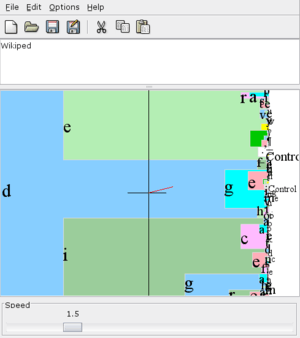Dasher (software)
Dasher is an input method and computer accessibility tool which enables users to compose text without using a keyboard, by entering text on a screen with a pointing device such as a mouse, touch screen, or mice operated by the foot or head. Such instruments could serve as prosthetic devices for disabled people who cannot use standard keyboards, or where the use of one is impractical.[2][3]
 Dasher running under Linux | |
| Developer(s) | The Dasher Project |
|---|---|
| Stable release | 4.11
/ 14 March 2010 |
| Preview release | 5.0 beta
/ 8 April 2016[1] |
| Written in | Java, C and C++ |
| Operating system | Cross-platform |
| Type | Computer accessibility |
| License | GPL |
| Website | www |
Dasher is free and open-source software, subject to the requirements of the GNU General Public License (GPL), version 2. Dasher is available for operating systems with GTK+ support, i.e. Linux, BSDs and other Unix-like including macOS, Microsoft Windows, Pocket PC, iOS and Android.[4][5][6]
Dasher was invented by David J. C. MacKay and developed by David Ward and other members of MacKay's Cambridge research group. The Dasher project is supported by the Gatsby Charitable Foundation and by the EU aegis-project.[7]
Design
Whatever the writer uses as a pointer, he/she selects a letter from ones displayed on a screen, whereupon the system uses a probabilistic predictive model to anticipate the likely character combinations for the next piece of text, and accord these higher priority by displaying them more prominently than less likely letter combinations. This saves the user effort and time as they proceed to choose the next letter from those offered. The process of composing text in this way has been likened to an arcade game, as users zoom through characters that fly across the screen and select them in order to compose text. The system learns from experience which letter combinations are the most popular, and changes its display protocol over time to reflect this.
Features
The Dasher package contains various architecture-independent data files:
- alphabet descriptions for over 150 languages[8]
- letter colours settings
- training files in all supported languages
References
- https://github.com/ipomoena/dasher/releases
- Wills, S. A.; MacKay, D. J. C. (2006). "DASHER—An Efficient Writing System for Brain–Computer Interfaces?". IEEE Transactions on Neural Systems and Rehabilitation Engineering. 14 (2): 244–246. CiteSeerX 10.1.1.63.5063. doi:10.1109/TNSRE.2006.875573. PMID 16792304.
- David J. C. MacKay (6 October 2003). Information theory, inference, and learning algorithms. Cambridge University Press. p. 119. ISBN 978-0-521-64298-9. Retrieved 18 December 2011.
- Inference Group (University of Cambridge): Mobile Dasher. Accessed 2013-01-17.
- Dasher for iOS on iTunes. Accessed 2013-01-17.
- Dasher for Android on Google Play. Accessed 2014-06-04.
- aegis-project
- http://www.inference.phy.cam.ac.uk/dasher/download/alphabets/